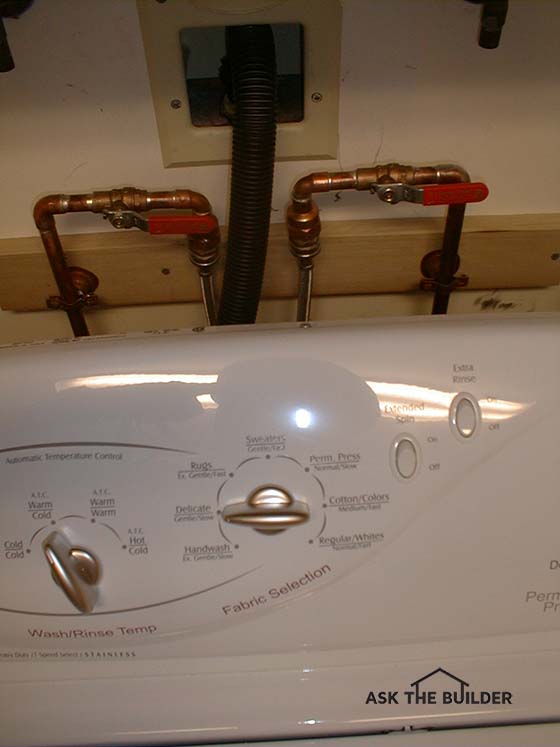Caring for Water and Drain Lines

This is what the drain pipe for your washing machine might look like if you had x-ray vision and could see into your walls. The u-shaped pipe near the floor is a trap that holds water. It prevents sewer gas and vermin from entering your home. Copyright 2023 Tim Carter
Clean plumbing pipes are easy to have in your home. Sop up grease from pots, pans, and plates and discard in the garbage. Pour five gallons of hot water down drain lines once a month.
Revised February 2018
Clean Plumbing Pipes - Easy To Achieve Once A Month
DEAR TIM: The water in my kitchen sink drained slowly for a period of months. Last week it stopped draining completely.
A plumber discovered the drain line was clogged with grease. I can't believe this happened as I have been very careful about wiping out my cooking pans. The plumbing service call was very expensive.
Are there things I should do on a regular basis to prevent clogged drain lines? Are there other preventative maintenance things that should be done for my water supply lines? Pamela S., Twin Falls, ID
Related Links
Drain Cleaner Debate - Do They Really Work?
Drain Cleaners & Methods That Absolutely DO Work!
Free & Fast Bids
CLICK HERE to get FREE & FAST BIDS from local drain-cleaning contractors.
Clean Plumbing Pipes Start With Grease Control
DEAR PAMELA: As much as I hate to say it, I don't think you were careful enough. If you're connected to a septic system, your nightmare may be just beginning.
Grease can and does wreak havoc on both the septic tank as well as the drain lines in the leach field. Never pour any grease down any drain line that's connected to a septic system.
If you're on a city sewer, grease can still cause problems over time, as it can completely clog the large-diameter sewer line that leads from your home to the street.

Flushing out sink drain lines can be as simple as filling them with warm soapy water. Photo by: Tim Carter
Save Used Paper Towels For Grease
Many years ago, my mother taught me a trick. I'd see her use a paper towel and it really wasn't that dirty. She'd lay it on the counter to dry.
The dried towels would be stored in a paper bag. She'd recycle these used towels to soak up grease from skillets, pans, pots, and dishes. These grease-soaked towels would go in the garbage.
This simple task really works to stop grease from coagulating in drains and city sewer lines.
Paper Towels & Grease Video
This may seem like a silly video, but it shows you how well paper towels deal with grease. It's a short video.
Maintain Drain Lines With Water
Many people are unaware that plumbing drain lines and water lines can benefit from simple and periodic maintenance. Drain lines are simple to maintain.
The first thing you need to understand is that it takes quite a bit of energy to move solid objects from your home out to the septic tank or the city sewer line. Often the journey is 100 feet or more.
Flowing water contains lots of energy. Pouring lots of water in drain lines helps flush out debris.
If the main building drain line under your slab or basement and in your yard has minimal pitch, the friction inside the pipe can slow the flow of water. A bigger problem can be too much pitch. If drain lines have too much slant to them, the water in the pipe can actually outrun the solids and leave them behind to accumulate. One-quarter inch of fall per foot of run in drain lines provides for excellent drainage.
Fill All Sinks With Hot Water
It is a great idea to fill all sinks to the brim with hot water once a month. Pull the stopper up and let the water out of the vessel. The volume of water and the hydrostatic pressure of the large volume of water will completely fill the drain line in the wall and possibly the drain stack. This rushing water helps to keep the drain lines squeaky clean.
Drain All Sinks & Toilets At The Same Time
To achieve the same results for the primary vertical drain stacks and the buried building drain under your floors, you must fill all sinks, tubs, etc. in the house at the same time. With the help of family members and friends, pull the stoppers in all fixtures at the same time and flush all toilets simultaneously.
This massive slug of water will help to keep your primary drain line clear of obstructions.
Exercise Water Shut-Off Valves
Water supply lines need little care but the shut-off valves to sinks and other fixtures do need maintenance if you expect them to work when you need them. It is a great idea to exercise valves every six months.

Turning these valves on and off monthly is a great idea to exercise them. Here are two ball valves that control the hot and cold water to my washing machine. I have them up above the machine in view so it's easy to operate. I also exercise them once a month so they don't get stuck. Copyright 2017 Tim Carter CLICK THE IMAGE NOW TO ORDER BALL VALVES.
This simply means closing a valve and then reopening it. If the valve has a traditional stem, this may cause a tiny leak around the valve stem. Simply use an adjustable wrench and tighten the packing nut to stop the leak.
If you want to avoid valve stem leaks, I suggest you install ball valves whenever possible. Ball valves cost just a few dollars more than standard valves. But because of their internal design, they allow for full water flow. Ball valves also are much more reliable than traditional washer-type valves.
3 Responses to Caring for Water and Drain Lines